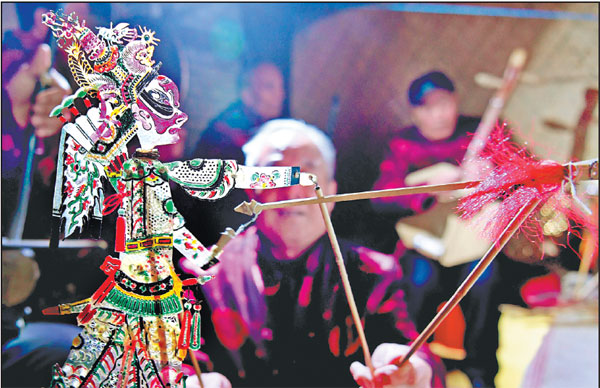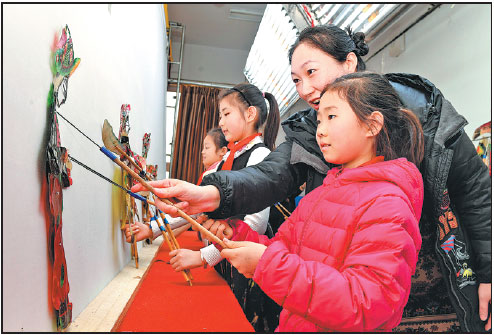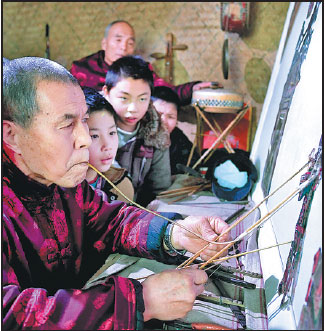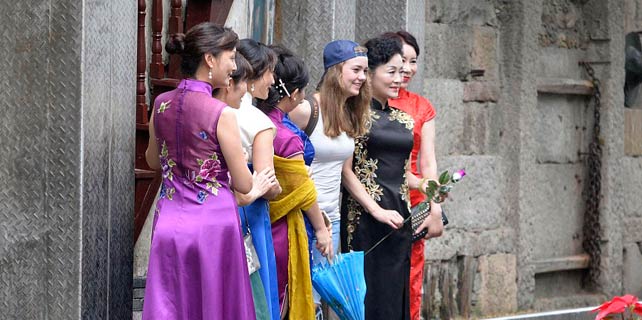Shadow puppetry returns to spotlight
A one-man mission is helping the ancient Chinese art form fight off competition from modern entertainment
Two warriors in ancient costumes fight ferociously when suddenly, to the dramatic sound of drums, the red-faced warrior pulls out his sword and beheads his white-faced enemy.
This is not a scene from a film, but a traditional Chinese shadow puppet performance, where colored silhouette figures made from cowhide show how Guan Yu, a prominent ancient general who symbolized loyalty, honor and strength, fought during his many battles.
Behind the curtain is the soul of the performance - puppeteer Wang Biao. Using his dextrous hands, and voice, he makes the small figures stroke their beards, nod their heads, wave their hands and curse others.
"This performing art has run in my family for seven generations," said Wang, 52, from Langzhong in Southwest China's Sichuan province.
Despite its long history, shadow puppetry is under threat from modern entertainment alternatives, such as television and cinema.
Wang is trying to bring people's attention back to the traditional art. With the support of a national fund, he is currently teaching 20 students from across the country the skills needed to master the art of puppetry.
"I hope that this folk culture will survive the threat of modernity and thrive in the future," he said.
Ancient origins
Ancient Chinese historical records show that shadow plays were originally created by a Chinese Taoist during the Han Dynasty (206 BC-AD 220) to console the heartbroken Emperor Wu, who had to deal with the death of one of his imperial concubines. The Taoist made a stone image of the concubine and put it in a tent by a burning candle. The shadow cast looked like the emperor's loved one and helped his sadness fade away.
Over the next 2,000 years, the stone figures gradually became cowhide ones, and the tents were turned into curtains. Performers then added drums and Chinese opera to the movement of the figures, and shadow play was born.
Wang first watched a shadow performance when he graduated from junior school.
"I thought it was humorous and eye-catching, and the figures were quite colorful," he said.
Wang's grandfather, a renowned shadow puppet performer in northern Sichuan, would take Wang along during his performances.
"He even paid a professional shadow performer to teach me," Wang said.
However, learning is difficult and it can take years before puppeteers are ready to go on stage.
"Every movement has to be on point," Wang said. "You need to memorize the whole script, and sing the lines of many different characters, while showing their emotions with the puppet strings."
Shadow plays went through a hiatus during the "cultural revolution" (1966-76), but reemerged in the early 1980s, when the art was involved in rural marriage ceremonies, funerals and banquets.
However, since China's reform and opening-up began in the 1980s, a large number of rural residents have moved to cities for employment, while domestic appliances like TV sets and radios have become common. The ancient art began to lose younger audiences and had to compete with modern entertainment.
Passion for puppetry
Wang gave up puppetry in 1991 and went to the southern metropolis of Shenzhen in Guangdong province to work on a pig farm. He soon made lots of money, but maintained his passion for puppet plays.
"I told myself that I could not let the art slip through my hands," Wang said.
In 2000, he went back to Sichuan and, with the help of a friend, put on a show in Chengdu, the provincial capital. The performance was a huge success and generated significant media attention.
Four years later, Wang went back to his hometown and started a shadow play troupe.
Meanwhile, he continued to look for people willing to learn the art.
In 2007, he recruited 22 students. He broke the tradition of imparting the skill only to male students, by recruiting both males and females, giving each of them 600 yuan ($85) in subsidies every month.
But his efforts were to no avail. Most of the students looked at learning the art as a temporary job and gradually left.
The last student to leave Wang's troupe was his favorite - the student told his teacher that he was going to join the army.
"I gave him 1,000 yuan and bought him some fruit before sending him on his way," Wang said. "After that, I closed all the doors and cried."
Wang then locked himself in his room for the entire day, believing his craft was dying out for good.
He later told his story to an official from the Ministry of Culture, who complimented him for "doing a worthy thing".
"Related laws and regulations protecting the art are still under discussion," the official told Wang.
In June 2011, China issued a law protecting intangible cultural heritage. In the same year, shadow puppetry was added to a UNESCO List of Intangible Cultural Heritage.
"Since then, I have felt like I am no longer alone in protecting cultural heritage," Wang said.
In the past few years, the upper limit of funding Wang can apply for has risen from 300,000 yuan to 1.5 million yuan per year, and he also receives 20,000 yuan in subsidies each year from the government.
A 4,200-square-meter museum of shadow puppetry is now under construction on a main street in his hometown, which will display the 50,000 puppets Wang owns.
Wang hopes to train more talent and create more shadow-performance programs.
"I'm just glad that shadow plays are crawling out of the shadows in the modern era," he said.
|
A puppeteer performs a traditional shadow play at Huazhou Shadow Puppet Culture Hall in Huazhou, Shaanxi province.Tao Ming / Xinhua |
|
Students practice shadow puppetry under the guidance of their teacher at Zhongshan Experimental School in Luanxian, Hebei province.Mu Yu / Xinhua |
|
|
(China Daily USA 04/27/2017 page7)



















